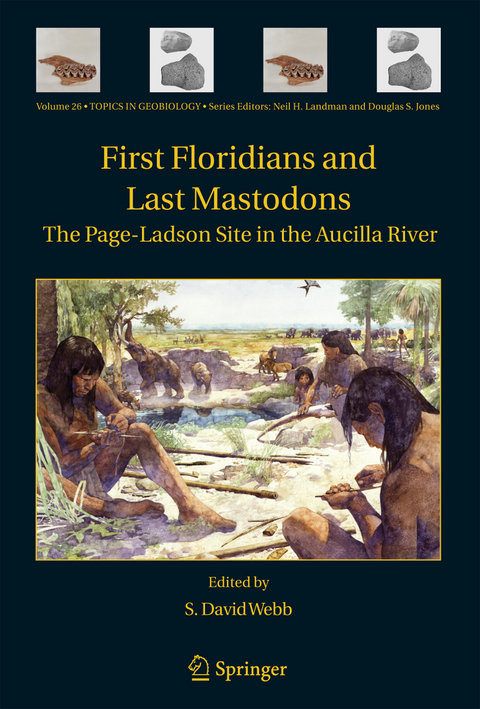
First Floridians and Last Mastodons: The Page-Ladson Site in the Aucilla River
Springer (Verlag)
978-94-024-0458-6 (ISBN)
Over the last 20 years the Aucilla River Prehistory Project has been one of the most f- cinating stories unfolding in Florida. This project, uncovering the remains of plants and animals from the end of the last Ice Age and the beginning of Florida’s human oc- pation, is answering questions important to the entire western hemisphere. Questions such as when did people first arrive in the Americas? Were these newcomer scavengers or skillful hunters? Could they have contributed to the extinction of the great Ice Age beasts – animals such as elephants – that were creatures native to Florida for the pre- ous million or so years? And how did these first Florida people survive 12,000 years ago at a time when sea level was so low that this peninsula was double its present size, sprawling hugely into the warm waters of the Caribbean? Much of Florida at that time was almost desert. Fresh water – for both man and beast – was hard to find. The lower reaches of today’s Aucilla River are spellbinding. Under canopies of oak and cypress, the tea-colored water moves slowly toward the Gulf of Mexico, sometimes sinking out of sight into ancient drowned caves and then welling up again a few feet or a few miles downstream. Along the river bottom, the remains of long extinct animals and Florida’s earliest people lie entombed in orderly layers of peat, sand, and clay.
During four decades of service to the Florida Museum of Natural History, David Webb led paleontological excavations at two dozen major sites within the Late Cenozoic Era. Some of these, including the Aucilla River Prehistory Project, involved unique SCUBA excavations yielding extraordinary wet-site preservation. Professor Webb served as President of the Society of Vertebrate Paleontology, Guggenheim Fellow in western Europe, Visiting Professor of Geology at Yale University, and Distinguished Visiting Curator at the Field Museum in Chicago. He has conducted field work in Central and South America, Africa, China and Australia. He has edited or authored six books, and written some 200 scientific papers. Outstanding specialists from other leading universities, U of Colorado, Columbia, Michigan, Minnesota, Pennsylvania, Santa Cruz, Stanford, and Texas have lent their expertise to this extraordinary project.
Geology.- Underwater Excavation Methods.- Geography and Geomorphology of the Aucilla River Region.- Stratigraphy and Sedimentation.- Carbon Dates.- Pleistocene–Early Holocene Climate Change: Chronostratigraphy and Geoclimate of the Southeast US.- Paleobotany.- Setting the Stage: Fossil Pollen, Stomata, and Charcoal.- Paleoenvironmental Aspects of the Macrophytic Plant Assemblage from Page-Ladson.- Late pleistocene evidence.- Vertebrate Paleontology.- Non-marine Mollusca.- Mastodons (Mammut americanum) Diet Foraging Patterns Based on Analysis of Dung Deposits.- Mastodon Tusk Recovery.- Five Years in the Life of an Aucilla River Mastodon.- The Biogeochemistry of the Aucilla River Fauna.- Paleoindian Archaeology.- Early holocene evidence.- Terrestrial Soil or Submerged Sediment: The Early Archaic at Page-Ladson.- Early Holocene Vertebrate Paleontology.- Biogenic Silica as an Environmental Indicator.- Early Archaic Archaeology.- Hearths.- Conclusions.- Paleoindian Land Use.- Conclusions.
| Erscheinungsdatum | 09.07.2016 |
|---|---|
| Reihe/Serie | Topics in Geobiology ; 26 |
| Zusatzinfo | XXV, 588 p. |
| Verlagsort | Dordrecht |
| Sprache | englisch |
| Maße | 155 x 235 mm |
| Themenwelt | Geisteswissenschaften ► Archäologie |
| Naturwissenschaften ► Biologie ► Ökologie / Naturschutz | |
| Naturwissenschaften ► Biologie ► Zoologie | |
| Naturwissenschaften ► Geowissenschaften ► Geografie / Kartografie | |
| Naturwissenschaften ► Geowissenschaften ► Geologie | |
| Naturwissenschaften ► Geowissenschaften ► Mineralogie / Paläontologie | |
| Sozialwissenschaften ► Ethnologie | |
| Sozialwissenschaften ► Soziologie | |
| ISBN-10 | 94-024-0458-9 / 9402404589 |
| ISBN-13 | 978-94-024-0458-6 / 9789402404586 |
| Zustand | Neuware |
| Haben Sie eine Frage zum Produkt? |
aus dem Bereich


